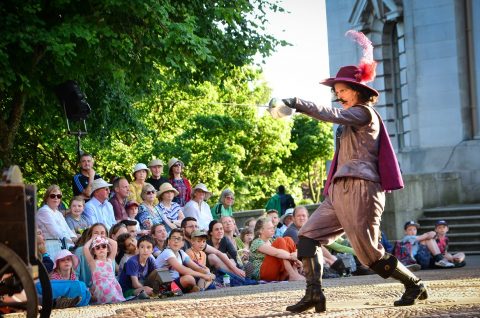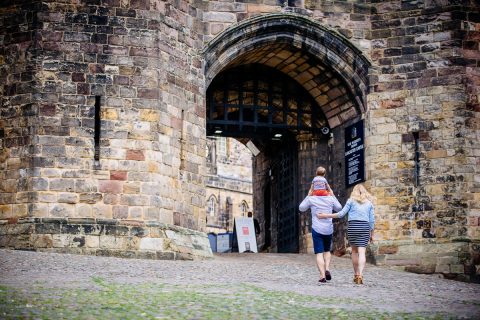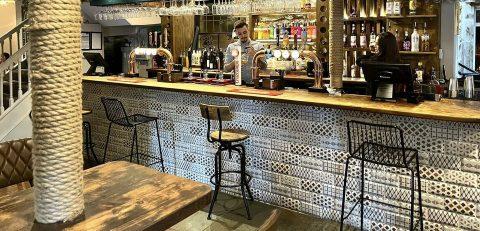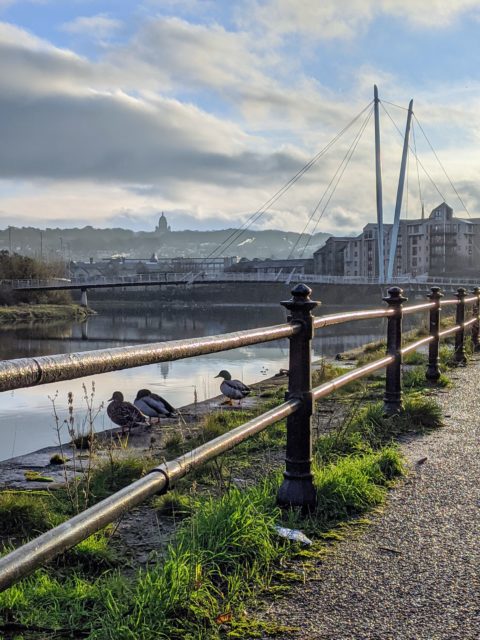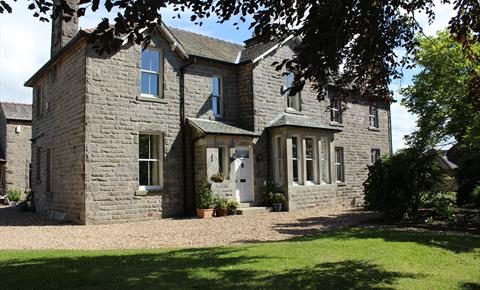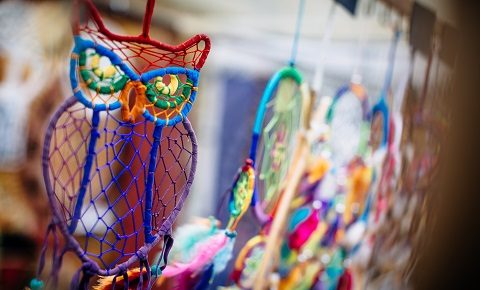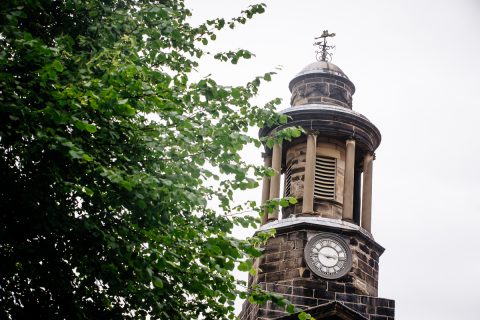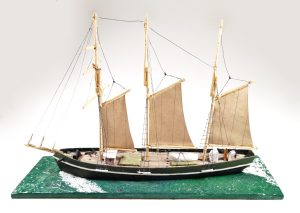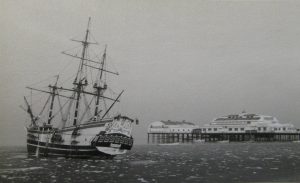Lancaster’s Little Ships
We have recently accessioned a lovely set of objects into the collections. Donated at the end of last year they are a set of 14 models of boats that used to sail out St George’s Quay between the 1920s and 1960s. They were the last commercial ships to sail out of the Quay. This little fleet was known as ‘Lancaster’s Little Ships’ and were owned by a businessman called Robert Gardner. The models were made by local resident Jeffrey Dade.
The Gardner family had connections to the local maritime trade before Robert was born in 1888. His father, Richard William Baxter Gardner, had been a fisherman and river pilot and became the Harbour Master for the Port of Lancaster when he was 70 years old, remaining in the job until his death at the age of 82.
Robert became a clerk with shipbroker J.H.Ball based on St George’s Quay and also worked for Ball’s successor Harry Dingle. In 1920, when Robert was 32 he assumed control of the Dingle company and renamed it after himself. The company grew and Robert started a fleet of small cargo ships which he used to transport building materials and commercial goods around the coast of the UK and Europe. He bought his first ship, a steamship called the Grosvenor, in 1924, with several other boats following in the next few years.
When the former isolation hospital at Marsh Point was abandoned in the later 1920s Gardner bought it and turned it into the main offices for his shipping business. The main Quay was silting up and this property, further down the river, allowed Gardner to continue to run his fleet. There was a slump in shipping trade in the early 1930s but in the late 1930s things recovered and Gardner purchased the rest of his fleet of little ships. The names of his ships were Grosvenor, Depositor, Dela, Vulcan, Mountcharles, Dorit, Shifter, River Loyne, Ryelands, Rambler, Multistone, Maurita, Lancaster City and Calyx.

Most of Gardner’s ships were eventually sold on to other companies or to be broken up, but some had more tragic ends. Grosvenor was wrecked on Holy Island in December 1935 while en route to Sunderland. Mountcharles foundered in heavy weather off Padstow in 1953 while on a passage to Lancaster carrying a cargo of china clay. Rambler was driven ashore by high winds off the Isle of Whithorn in 1930.
Both River Loyne and Maurita were lost with all hands during the Second World War, River Loyne when it went down in the Menai Straits while carrying a cargo of stone to Liverpool, and Maurita after hitting an enemy mine while bringing coal back to Lancaster from Scotland.
However, one of his fleet went on to a happier and more glamourous life after being sold by Gardner. Ryelands, a wooden three-masted schooner built in 1887, was purchased by Walt Disney Productions in 1949 and used as the Hispaniola in their film Treasure Island. After that it was purchased by another film company and featured as the Pequod in Moby Dick and Moulin in Dilipa. Finally, it was moored at Morecambe Old Jetty as a tourist attraction and floating restaurant where it was referred to as ‘Moby Dick’ before being damaged by fire in 1970 and subsequently broken up.
Read on for more details on the individual ships.
GROSVENOR
This was the very first ship in Robert Gardner’s fleet. She was a single screw steamship built in 1907, and had already passed through the hands of five different owners before she was purchased by Gardner in March 1924. (Even later, as his business grew, Gardner was never to buy a ship brand new. Whether he was simply thrifty or was following the old ship-owner’s rule ‘fools build, wise men buy’, this strategy certainly paid off!)
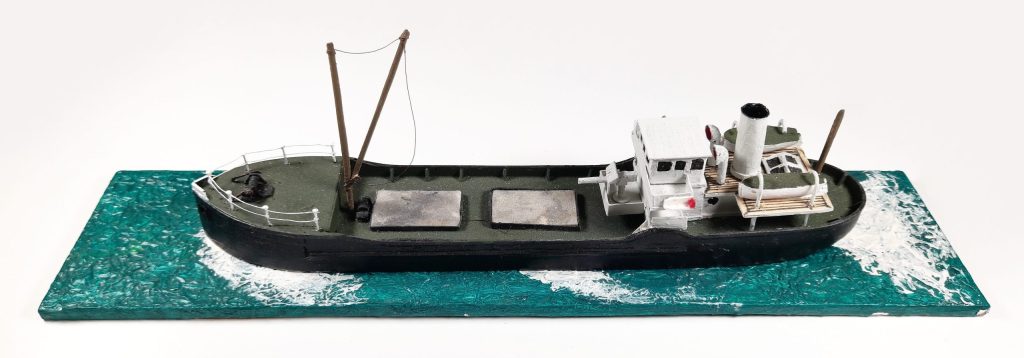
After a decade of service carrying cargo in and out of Lancaster, Gardner sold the Grosvenor on again to a buyer in Aberdeen. But sadly, her story was soon to come to an abrupt end. Whilst on a passage from Portknockie to Sunderland the little ship was wrecked on Holy Island, Northumberland, on 18th December 1935.
DEPOSITOR
This iron hopper barge was purchased by Gardner in April 1924, just a month or so after he bought the Grosvenor. Depositor was a single screw steamship of about the same size as the Grosvenor, but the similarities ended there. Depositor was significantly older, built in 1872 in Glasgow. Gardner acquired her to handle a Government contract he’d won, dumping surplus ammunition and explosives in the Irish Sea. This kept the Depositor busy for a couple of years, after which Gardner had her fitted with a grab crane to dredge gravel from the river bed. (A never-ending task in the shifting estuary of the Lune!)

In 1928 Gardner sold Depositor to the Fleetwood Sand & Gravel Company. By then she was more than half a century old, and didn’t last much longer. She was broken up for scrap in 1931.
DELA
Bought by Gardner in September 1924, this was the first motor vessel to be added to the fleet – both of Gardner’s earlier purchases being steamships. Dela was built in 1915 as an X-lighter for the Admiralty and then sold off after the end of WW1. She was converted into a hopper barge complete with bottom doors for dumping at sea.
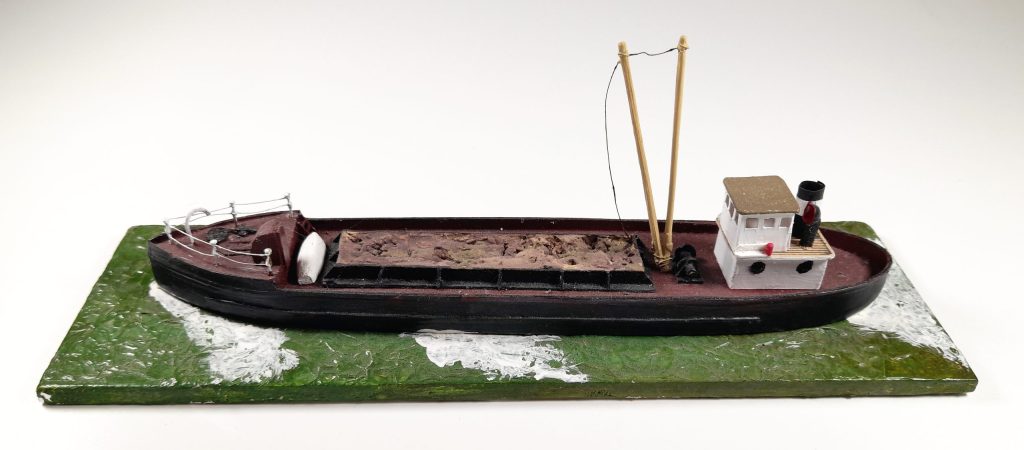
By the time Gardner bought the Dela she’d already passed through the hands of several other owners in the North-West and acquired a new engine along the way. Like the Depositor, Gardner primarily wanted the Dela to fulfil a government contract dumping surplus ammunition in the Irish Sea. He kept her for some time after the contract was complete, then sold her on again to a London-based company in 1936. Later that same year she was wrecked on Buxey Sands near Clacton while carrying a cargo of sand from Fingringhoe to London.
VULCAN
Only half the size of Gardner’s first three ships, Vulcan was a Glasgow-built single screw steamship of the Clyde ‘Puffer’ type, dating from 1895. Gardner acquired her in December 1924. At 44 tonnes and a length of 66 feet she could be handled by a crew of only three people and could make use of harbours and inlets that were too small or shallow for most cargo vessels. Gardner put her to work in the coastal trade, transporting anything from bricks to zinc oxide around the North-West and Wales, as well as the gravel dredged up by Depositor. Vulcan remained a part of Gardner’s fleet until the end of her working life in 1928, when she was sold off to be broken up.
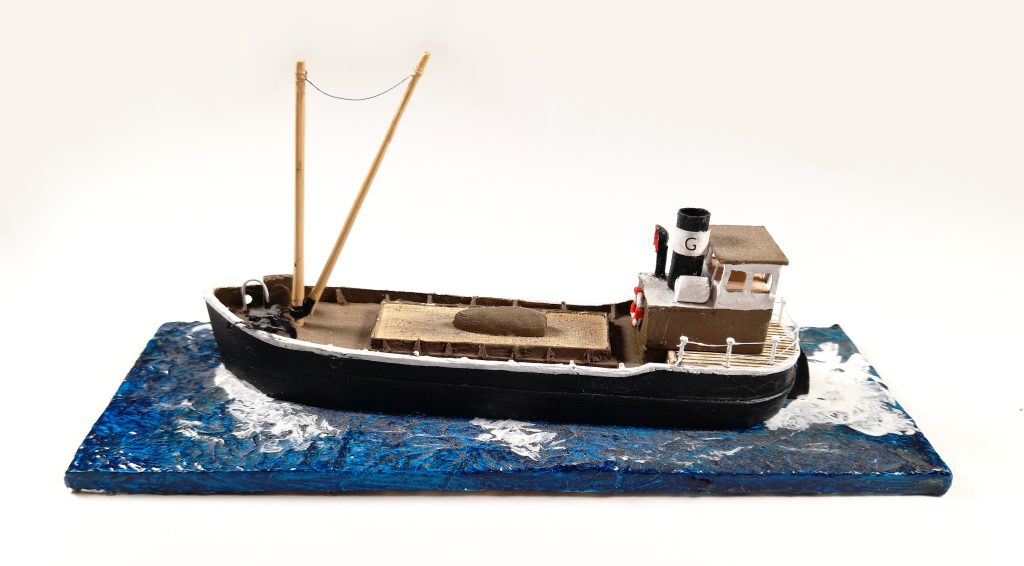
MOUNTCHARLES
Bought by Gardner in 1925, this was the largest ship to be added to the fleet so far. She also turned out to be the longest-lasting, remaining a key part of the fleet for the next twenty-eight years. Built in 1910 in North Shields, she was a single screw steam ship, not too different from Gardner’s first purchase, the Grosvenor.
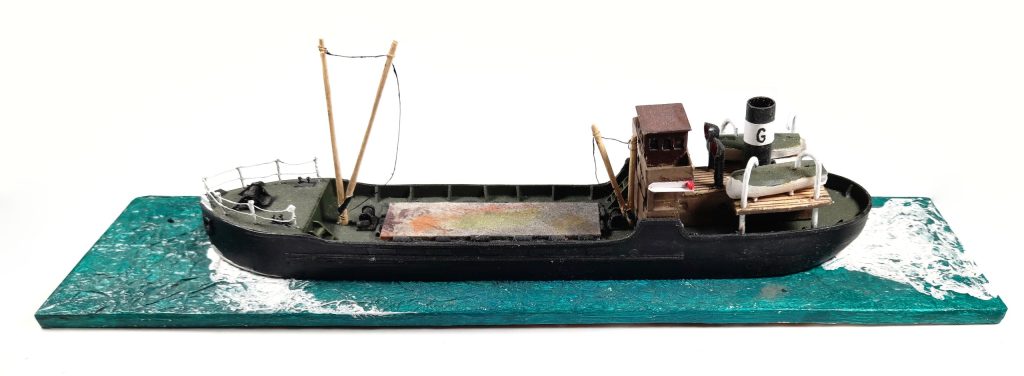
Mountcharles was to carry bulk cargo over relatively long distances, including regular visits to Cornwall to collect china clay destined for the Williamson factories in Lancaster. It was on one of these voyages that she eventually foundered and sank near Padstow in 1953. Plymouth’s ‘Western Morning News’ later described her end:
‘In heavy seas off Hartland Point she just opened up and sank. She went down quietly and not too fast, for all her crew were saved. Hers was the most graceful death. After all, she was old, and it was that or the breaker’s yard.’
DORIT
Like the Dela, Dorit was originally designed as an X-lighter for the navy. She was a single screw motor vessel built in 1915 in Newcastle. Converted for civilian use in 1921 she became a hopper barge with bottom doors for dumping at sea (again, much like the Dela). Gardner purchased her in September 1925.
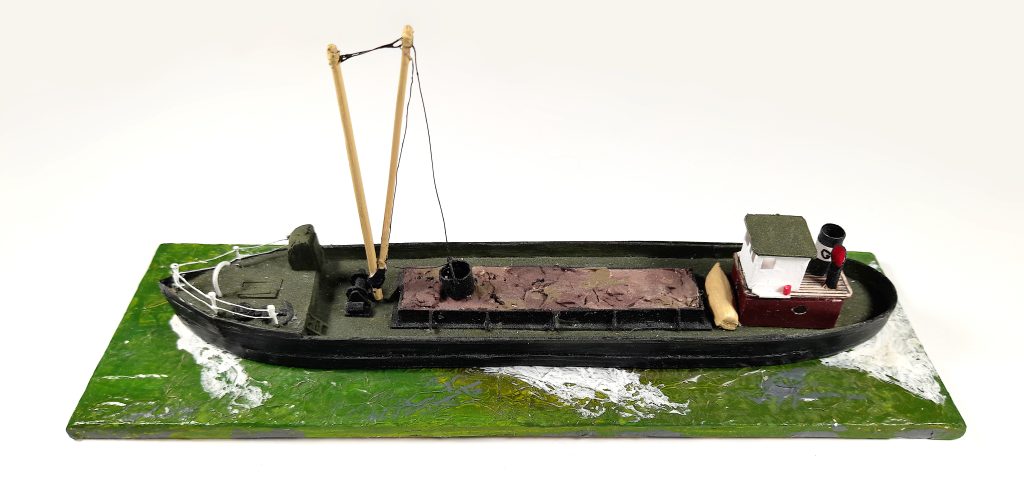
Dorit didn’t remain a part of Gardner’s fleet for very long. After only three years, he sold her to a Spanish company. That was far from the end of her story though, as she motored on for another couple of decades before eventually being reported lost in 1949 or 1950.
SHIFTER
Bought by Gardner in 1925, Shifter was a single screw steamship designed as a steel hopper barge and built in Hull in 1910. At 218 gross tonnes and 110 feet long, Shifter was typical of the types of ships purchased by Gardner to carry bulk cargo up and down the west coast. She didn’t remain in his ownership for very long though – he sold her on to a company in Southampton in 1929. She was eventually broken up in 1947 or 1948.
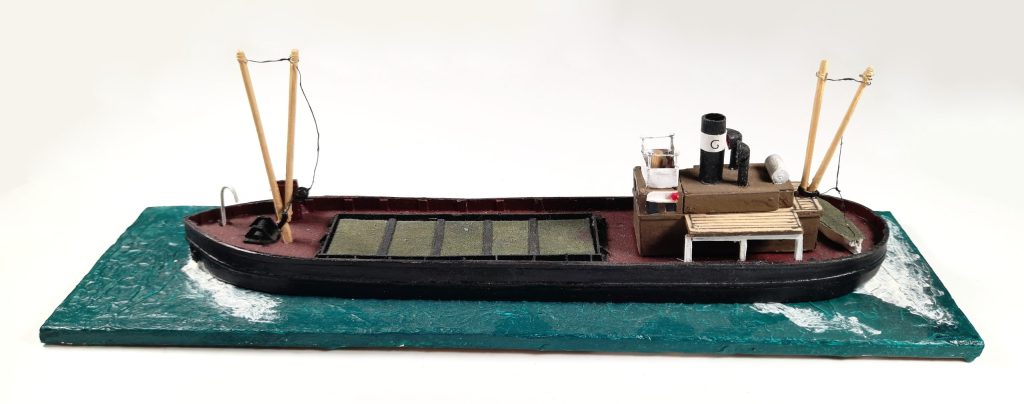
RIVER LOYNE
Previously known as Dyserth and then A.H.C., this ship joined Gardner’s little fleet in May 1926. She was a twin-screw motor ship originally built in 1916 as an X-lighter for the navy, much like Gardner’s earlier purchases, Dela and Dorit. During WW2 the River Loyne was taken over by the admiralty again for a short period from 1940 to 1941. Afterwards she was returned to civilian service in Gardner’s fleet, carrying bulk cargo up and down the coast.

River Loyne was well known – and ridiculed – in many ports because of her unusual appearance. This model shows the odd blunt-bowed design, as though the front of the ship has been chopped off! She was a reliable little ship though, and served Gardner well until 7th December 1948, when she was lost with all hands after leaving Penmaenmawr with a cargo of stone for Liverpool.
RYELANDS
Unusually for Gardner’s fleet of steamers and motor vessels, the Ryelands was a wooden three-masted schooner, built at Glasson Dock in 1887. She was destined for fame, appearing as the Hispaniola in Disney’s ‘Treasure Island’ in 1949 and later moored in Morecambe for many years as a tourist attraction under the name ‘Moby Dick’. But in Gardner’s time she was a working boat, and no-one could have guessed her future. She’d already passed through the hands of several different owners and consortiums before Gardner acquired shares in 1928 and then full ownership the following year. In 1929 she was fitted with an auxiliary oil engine to supplement her sails. Gardner kept her working in the entirely unglamorous coastal trade for almost 20 years before selling her on. He must have been astounded to hear about her later career as a film star!
RAMBLER
Bought by Gardener in 1929, Rambler was a wooden two-masted schooner built at Glasson Dock in 1889 – much like the Ryelands, which Gardner had acquired earlier that same year. Rambler was fitted with a paraffin engine to supplement her sails in 1925.

Sadly Rambler didn’t last long in Gardner’s fleet. She was driven ashore and wrecked in March 1930, whilst carrying a cargo of scrap from Belfast to Connah’s Quay. Gardner and his father both went to see the wreck in person, but the only thing which could be salvaged was the ship’s auxiliary engine.
After Rambler’s demise, Gardner was left with a fleet of five little ships: Grosvenor, Dela, Mountcharles, River Loyne, and Ryelands. A slump in trade in the early 1930s meant that it was to be some time before he purchased any more. He kept the business ticking over though, and had the foresight to plan ahead for better times.
Until this point, the company had been based in the old Custom House (now part of the Maritime Museum) on St George’s Quay. Historically this had been the centre of the Port of Lancaster, but access was becoming increasingly difficult as the river silted up. When premises became available further downstream in the form of the former isolation hospital at Marsh Point, Gardner bought the building for his new headquarters.
As he’d predicted, trade soon picked up again. In the mid-1930s Gardner began to look around for new vessels which might help expand his business:
MULTISTONE
In 1934, almost exactly a decade after he’d first begun to build his fleet, Gardner purchased the Multistone – a single-screw steamship built in 1910 in Middlesborough. She was a sister ship to Mountcharles, which had been in Gardner’s fleet since 1925. Both ships were originally built for a quarrying firm in Bristol. Mountcharles was probably named after one of their quarries, while Multistone’s name described her usual cargo. Gardner put Multistone to work in the coastal trade, taking over the jobs previously handled by the ageing Grosvenor, which he’d sold off earlier that same year.
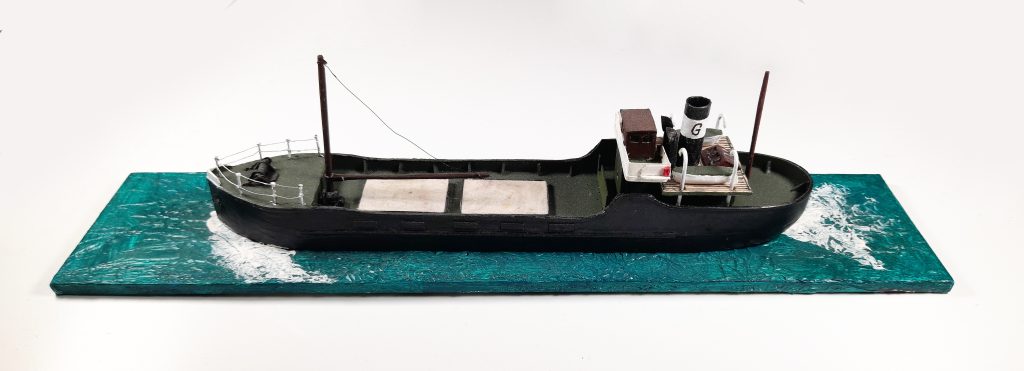
Like many cargo vessels, Multistone was commandeered by the Admiralty between 1940 and 1942 and temporarily re-registered in Glasgow before being returned to Gardner in Lancaster. She picked up where she’d left off and remained a part of Gardner’s fleet until 1955, when he sold her to a company in Portsmouth. She was eventually broken up in 1967.
MAURITA
Gardner acquired Maurita in 1935. She was the most up-to-date ship in the fleet, built in 1920 and with only one previous owner. She was a small single-screw steamship with a crew of five. She proved to be a useful but unlucky addition to the fleet: in 1937 she ran aground on a sandbank when her steering failed on a passage from Lancaster to Liverpool. The following year she was lying at anchor in thick fog when another of Gardner’s ships, the River Loyne, ran into her and damaged her stern. In 1939 she was wrecked on the coast of North wales and had to be recovered as salvage. She was badly damaged but was repaired and put back into service, only to be finally sunk by an enemy mine in the Dee estuary just a couple of years later in 1941. She went down with all hands and only the body of her Captain, Robert Hutton, was ever recovered.
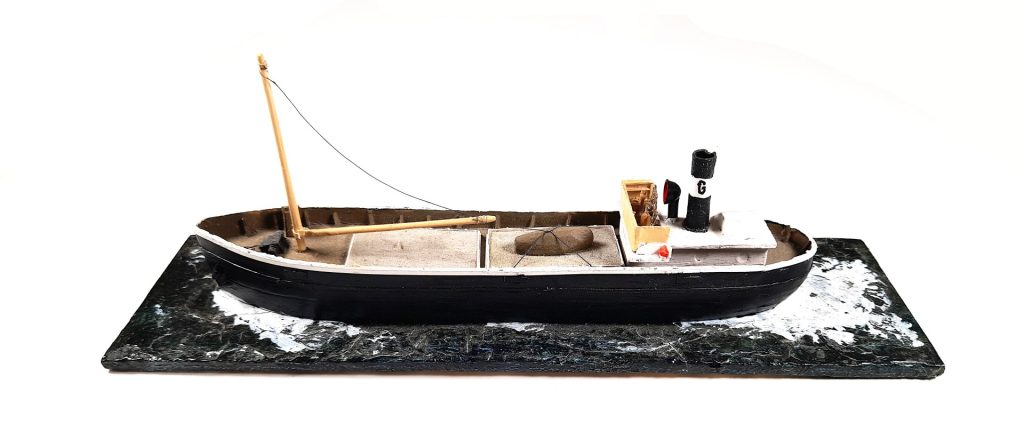
LANCASTER CITY
In contrast to the Maurita, Lancaster City was already almost half a century old when she was added to the fleet in 1937. She was built in 1895, but unlike many of Gardner’s ships she’d only had one previous owner – the Anglesey Shipping Company, owned by Baron Penrhyn. The Lancaster City was originally named ‘Penrhyn’, and the Baron wanted to retain the name after he sold her, so Gardner agreed to choose a new name for the ship. 1937 was the same year that the town of Lancaster officially became a city, and so he renamed her to commemorate this event. (Perhaps also after Lancaster City Football Club, formerly Lancaster Town FC – Gardner was a lifelong supporter!)

At 354 gross tonnes, Lancaster City was the largest vessel Gardner had ever purchased. Perhaps a little too large for the shallow and twisting access to Lancaster along the River Lune. After only three years, Gardner sold her on again to a company based in London. She was renamed a second time as ‘Cranley’, and lasted another decade before finally being broken up in 1950.
CALYX
Bought by Gardner in 1938, this was the last vessel to be added to his little fleet and also the most modern. Calyx was a single-screw diesel-engined motor vessel built in Holland in 1929.

The outbreak of WW2 the year after Gardner bought the Calyx inevitably caused problems for his shipping business. Some of his vessels were commandeered by the Admiralty, others destroyed or damaged by mines. Two more were wrecked in the decade following the war. By the mid-1950s he was left with only two, Multistone and Calyx. By this time the shipping trade in Lancaster had gone into decline, and rather than replace the ships he’d lost Gardner decided to downsize even further, selling off the Multistone in 1955. The Calyx soldiered on alone, mainly transporting supplies for Gardner’s own building supplies company.
Robert Gardner died in 1957. Many of the family ventures he’d developed carried on, but the shipping side of his business outlasted him by only a few years. Calyx’s final arrival in Lancaster was on 9th June 1962, carrying a cargo of granite chips from Wales. After this she was laid up in Glasson Dock until she could be sold. Over the next decade she passed through the hands of several different owners in the south of England before overturning and sinking near Ipswich Docks in 1973. She was re-floated afterwards, but only to be broken up for scrap.
The end of Gardner’s Little Fleet also marked the end of Lancaster’s long history as a commercial port. Gardner’s former offices in the Custom House are now a part of the Maritime Museum, and his later premises downstream have been replaced by new-build housing. The bustling quay has become a peaceful riverside walk and the only boats you’re likely to see are a few canoes or jet-skis!


